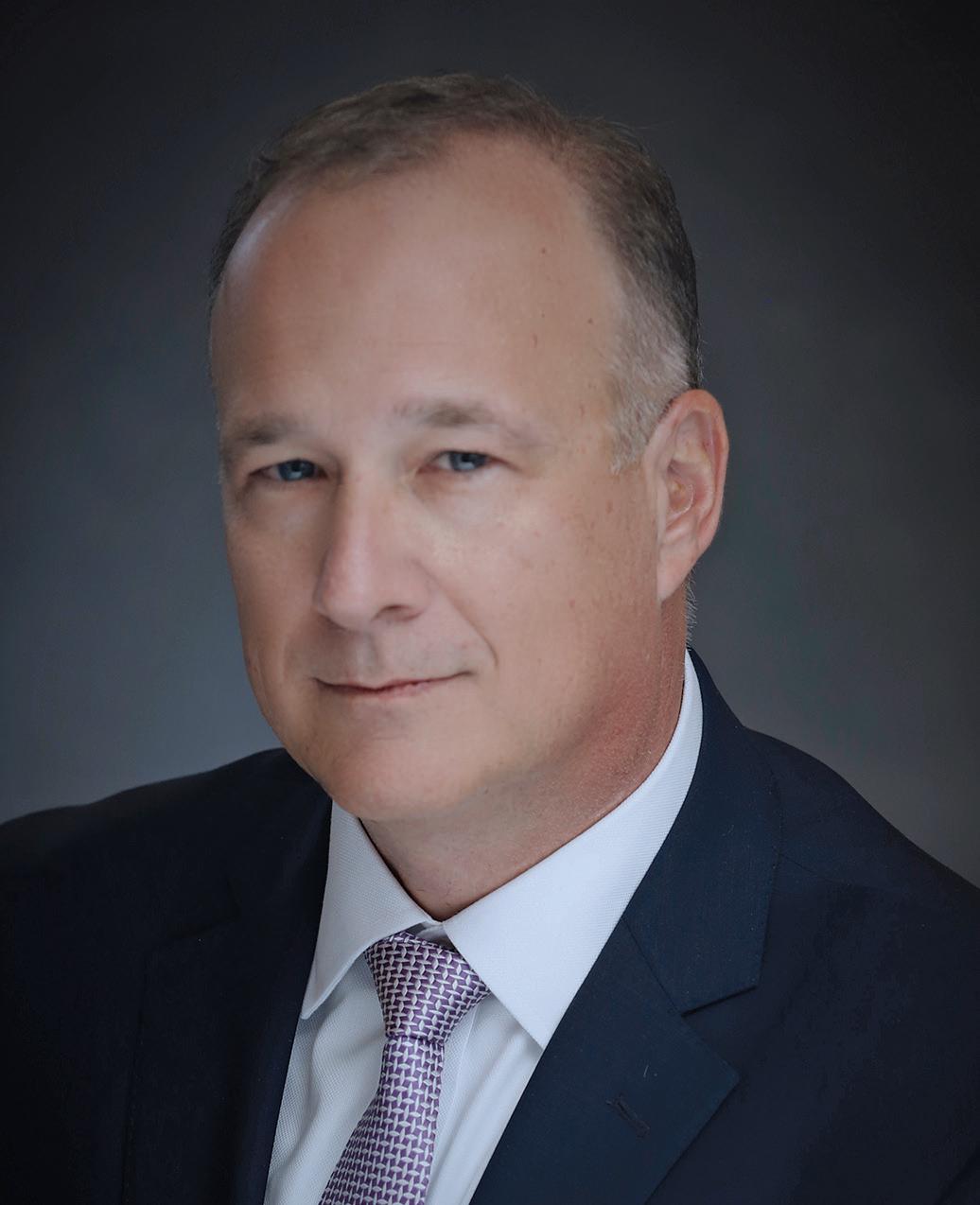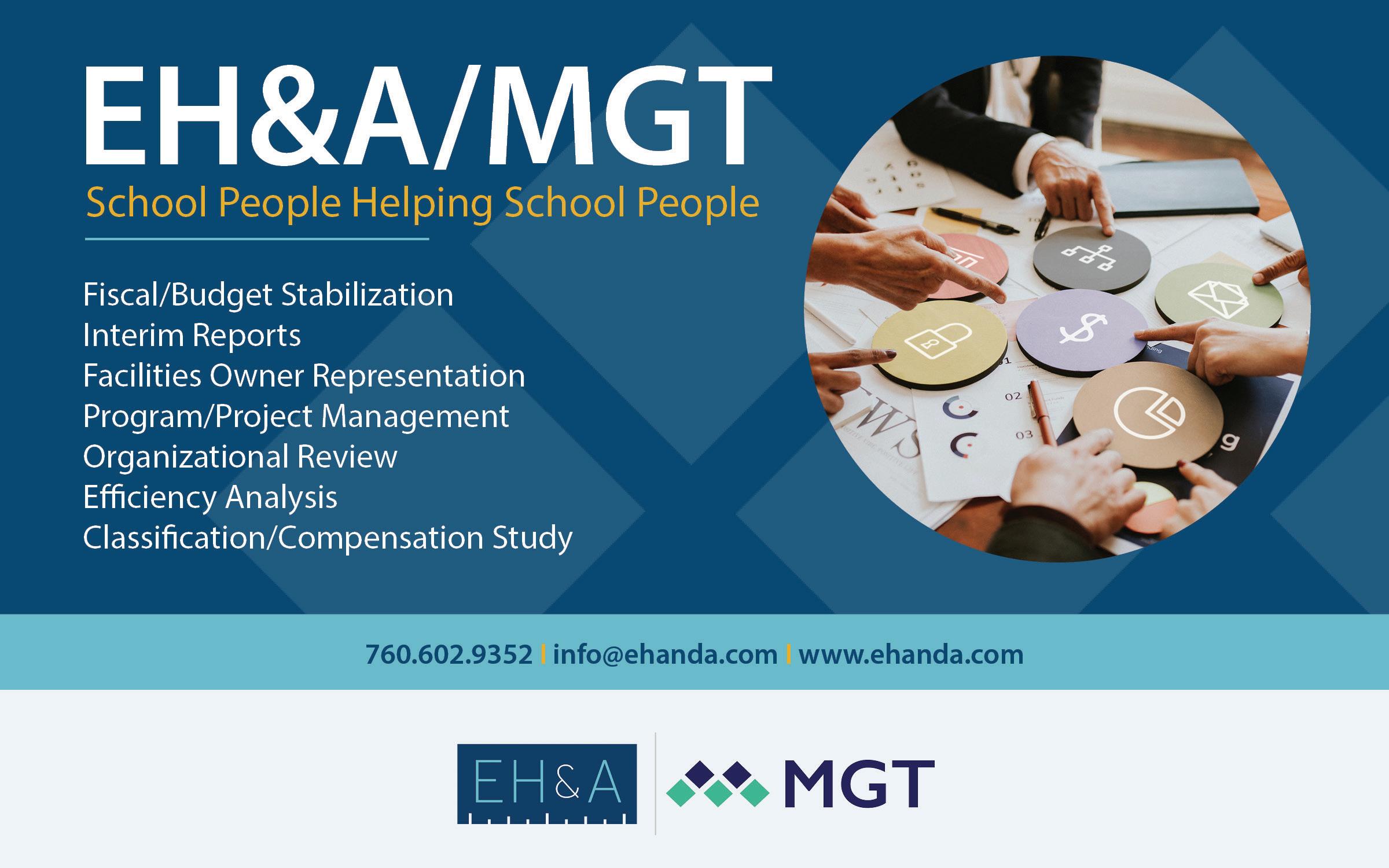
Real-world recruitment
4 realistic practices for attracting top talent
Stronger together
How the state’s education associations are uniting to advance shared goals


4 realistic practices for attracting top talent
How the state’s education associations are uniting to advance shared goals
MEDIA/COLLABORATION




Whether it’s a single room or an entire campus, a school is more than an educational resource. A school is a community where people thrive. Faculty, administrators and parents team up and rally around a common goal: wholly enrich the lives of their students.
So, when it comes to the facilities that house your school community, be sure to partner with a firm you can trust: Blach Construction. With 50+ years of proven modernization and new construction experience, Blach will empower you to deliver safe, healthy and contemporary spaces that inspire learning, creativity and growth –for each and every student.
Team up with Blach and together, we will build bright futures.
Everyone learns, and our most impactful learning experiences are shaped by our environment.





9
Tatia Davenport 11 BOTTOM LINE
Let CASBO help you unlock your bright future
Eric Dill
12 GUEST FEATURE What makes an inclusive leader?
Wei Zheng, Jennifer Kim, Ronit Kark and Lisa Mascolo
19 IN FOCUS MEMBER
Bob Whittenberg
21 IN FOCUS ASSOCIATE MEMBER
Kevin McDermott 24 INTERVIEW
Jennifer B. Wallace
Journalist and author weighs in on how to interrupt ‘achievement culture’ and support student and staff SEL
Julie Phillips Randles
Jennifer Fink 38 FEATURE Stronger together How the state’s education associations are uniting to advance shared goals
Jennifer Snelling



The California Association of School Business Officials is the premier resource for professional development in all aspects of school business. Founded in 1928, CASBO serves more than 24,000 members by providing certifications and training, promoting business best practices, and creating opportunities for professional collaboration. CASBO members represent every facet of school business management and operations. The association offers public school leaders an entire career’s worth of growth opportunities.
As the recognized authority in California school business, CASBO is a member-driven association that promotes ethical values; develops exceptional leaders; advocates for, and supports the needs of, members; and sets the standard for excellence through top-quality professional development and mentorship, meaningful collaboration and communication, and unparalleled innovation.
For the past 16 years, CASBO has been dedicated to the organizational planning discipline as a method for guiding the association into a successful future. Last year, the association completed its sixth such plan, CASBO by Design 2.0, a living, breathing document that guided the association in its long-term planning process, which is grassroots in nature, invigorating in procedure and motivating in outcome. Work on our next strategic plan began in 2021.
CASBO has long been committed to organizational planning because the approach has consistently helped the association envision its future and determine the clear steps to get there. The road map that strategic planning provides has allowed CASBO to remain focused on its unique mission, goals and objectives and to respond effectively to a continually changing environment.
For more information on CASBO by Design, visit casbo.org > CASBO + You > About > CASBO By Design.
Stay connected casbo.org
Publisher Tatia Davenport
Features editor
Julie Phillips Randles
Contributors
Jennifer Fink
Jennifer Snelling
Art director
Sharon Adlis
Ad production
Tracy Brown
Advertising sales manager Cici Trino Association Outsource Services, Inc. P.O. Box 39 Fair Oaks, CA 95628 (916) 961-9999
CASBO OFFICERS
President
Eric Dill
Carlsbad Unified School District
President-elect
Aaron Heinz
Colusa County Office of Education
Vice president
Katie Hylton
San Bernardino County Superintendent of Schools
Immediate past president
Tina Douglas
San Dieguito Union
High School District
consent of the publisher.
Published June 2024

Let




In times of adversity, such as California’s current budget crisis, our strength lies in unity.
This issue of our magazine showcases how school boards, administrators and school business officials are coming together to find common ground and create innovative solutions.
By pooling our diverse perspectives, we’re not only addressing today’s financial challenges, but also setting a powerful example for future leaders. Inclusive leadership, which values diverse viewpoints and encourages open dialogue, is key to our success. This collaborative spirit fosters problem-solving skills and demonstrates the effectiveness of teamwork.
As we look at the year ahead, remember that we’ve faced challenges before and emerged stronger. Together, we always find a way through, strengthening the bonds of our relationships and building a more resilient community of school business professionals.
Personally, I’m thrilled to be on this journey with you as we continue our focus on what truly matters – creating a better future for our kids. z z z
Tatia Davenport CEO
As a Third-Party Administrator (TPA), SchoolsFirst Plan Administration expertly manages the day-to-day responsibilities of California school employee retirement plans.
• We process your employee contributions securely with a remittance turnaround of 24 hours the industry.
• As a local and not-for-profit organization, we’re committed to delivering personalized service to you at all times.
• We provide complimentary financial education workshops, programs, articles and consultations.
We ensure a smooth transition by managing the entire process from start to finish.
CALL (800) 462-8328, ext. 4727
rpa@schoolsfirstfcu.org


I can think of three occasions in my school business career when promotional opportunities arose when I wasn’t expecting them. I was prepared, however, and I have CASBO to thank for that.
Building your knowledge and professional network now for the job you want later will pay off when the possibility to move up comes along.
How do you answer an interview question about your experience with a subject when you have never done that thing before? Memorize this response: “I haven’t had the chance to perform that work yet, but I am actively involved in CASBO and I know they have workshops and online resources that can help me quickly get up to speed on the topic. I also have a network of peers through CASBO who I can reach out to for assistance.”
Whenever I’m interviewing someone and suspect they don’t have experience that ties into a question I’m about to ask, this is the positive answer I’m looking for. It shows that the candidate is aware of the professional development resources that are available to them and that they can take responsibility for their own learning.
It’s certainly better than the worst reply I had from someone with no familiarity on a subject: “None. Next question.”
Here’s an even better response: “I thought you might ask me about this, so in preparation for this interview, I went to CASBO’s School Business University and took a class on this topic. I also attended a CASBO workshop on the subject. While I haven’t had a chance to perform this work yet, I’m familiar with the key concepts and processes, such as [give a few examples]. I also reached out to a colleague who does this now to get a better understanding, and they offered to help me when I get this job.”
This answer highlights your initiative, readiness for growth and peer support. You just have to be honest when you give that answer.
The first part of that answer is easy: Take advantage of all of the professional development CASBO has to offer, whether in person or online.
The second part requires you to venture away from your desk, get out of the office and meet your colleagues in school business. Go to the local workshops, go to local networking events, join a CASBO Professional Council, volunteer in your section, attend training in your county, get to know someone in another district who does your job or the one you want. These interactions will enrich your knowledge and skills, connect you with
like-minded professionals and prepare you for future roles.
I’ve never had anyone come back from a CASBO event and say, “Well, that was a waste of time.” So, get out there.
At the 2024 CASBO Annual Conference, keynote speaker Kim Scott said we shouldn’t dwell on “the worst thing that could happen.” But suppose you take my advice. Here’s the worst thing that will happen: You’ll learn something, you’ll get better at your job, you’ll be ready to advance and you’ll make connections with great people in school business who can help you in so many ways.
Dreadful, I know. z z z

Eric Dill President

By Wei Zheng, Jennifer Kim, Ronit Kark and Lisa Mascolo
Leaders play a critical role in fostering inclusivity within their organizations. They account for a difference of up to 70 percentage points in employees’ experience of belongingness and psychological safety, and inclusive leaders see a 17% increase in team performance, a 20% increase in decision-making quality and a 29% increase in team collaboration. Inclusive leaders also cut down employee attrition risk. If inclusive leaders are so influential, then inclusive traits like humility, curiosity and empathy should be treated as critical leadership capabilities rather than simply desirable. The authors conducted structured interviews with 40 DEI award-winning or peer-nominated exemplary inclusive leaders from a wide variety of job functions, organizations and industries. They identified five key behaviors that help leaders make their organizations more inclusive.
Organizational leaders are increasingly leveraging inclusion to attract talent, retain employees, and motivate high creativity and excellence. Indeed, inclusive organizations are 73% more likely to reap innovation revenue, 70% more likely to capture new markets, up to 50% more likely to make better decisions, and up to 36% more likely to have aboveaverage profitability.
Leaders play a particularly critical role: They account for a difference of up to 70 percentage points in employees’ experience of belongingness and psychological safety, and inclusive leaders see a 17% increase in team performance, a 20% increase in decision-making quality and a 29% increase in team collaboration. Inclusive leaders also cut down employee attrition risk by 76%.
If inclusive leaders are so influential, then inclusive traits like humility, curiosity and empathy should be treated as critical leadership capabilities rather than simply desirable. What concrete practices do leaders use to consistently foster belongingness and authenticity in their organizations – especially amid all their existing deadlines and demands?
We conducted hour-long structured interviews with 40 diversity, equity and
inclusion (DEI) award-winning or peernominated exemplary inclusive leaders from a wide variety of job functions, organizations and industries. We identified five key behaviors that help leaders make their organizations more inclusive.
1. Inclusive leaders strive for authenticity rather than leadership presence.
The leaders prioritized authenticity and psychological safety, viewing the two as essential building blocks for creating an environment where people can express themselves freely and air dissenting opinions without fear of retribution. They did this by modeling curiosity, humility and vulnerability.
For example, several interviewees criticized the idea of leadership presence, which conveys an infallible and superior image that a person has to project in order to be seen as a leader. Instead, they emphasized the importance of sharing their own vulnerabilities, citing it as a crucial ingredient for building trust and psychological safety among their team members. One leader humbly revealed his weaknesses to his staff, while another bravely shared the ups and downs of her
career journey in public forums. Yet another leader took it upon herself to share her failures with her team members in an effort to normalize mistakes and foster a culture of learning and growth. Finally, a leader in a design team regularly disagreed with her boss in front of her team so that her team members knew it was OK to question authority.
2. Inclusive leaders redefine the rules rather than unquestioningly following them.
The exemplars of inclusive leadership were not afraid to challenge wellestablished practices that had outlived their relevance. They actively sought ways to detect practices that excluded certain groups of people and replaced them with new ones that gave more access to underrepresented groups.
For example, one leader in a safetyfocused organization broadened the organization’s dress policies, including those pertaining to hair (to be more inclusive of women and African Americans) and tattoos (to be more inclusive of younger people), noting that previous practices were less related to safety and more based on stereotypes.
By constantly reexamining and revising entrenched practices, inclusive leaders are able to recruit and support a more diverse group of employees who contribute new ideas and add complementary value to their organizations.
Another leader in a professional services firm advocated for removing a candidate’s full-time or part-time status from partner promotion criteria because it was irrelevant to a person’s value to the organization, and it tended to penalize working mothers. One HR leader challenged managers to articulate what “culture fit” means in their organization and formally embedded clear definitions of it into the organization’s hiring guidelines. Several leaders created new team norms to make sure everyone was heard, such as rotating the order in which team members spoke during meetings or rotating the role of agenda-setter so that priorities in different areas would be voiced and addressed over time.
By constantly reexamining and revising entrenched practices, inclusive leaders are able to recruit and support a more diverse group of employees who contribute new ideas and add complementary value to their organizations.
3. Inclusive leaders embrace active learning and consistent implementation.
The interviewed leaders emphasized that the effort to be inclusive is actively learned, rather than passively acquired. They believed that our natural habits or inclinations usually contain biases and need to be constantly examined, challenged and changed in a planned and consistent manner to pave the way for inclusion. As a leader in a financial services firm put it, we cannot just hope to recruit more women and underrepresented employees – we need to deploy intentional, systematic processes to recruit them.
These intentional efforts take many forms; however, the ones that are especially useful are those that embed DEI practices into the existing processes and
systems to ensure consistency and accountability. Examples include mandating diverse candidate pools in recruitment, embedding inclusion efforts into performance metrics, coaching managers to facilitate feedback-giving among their direct reports and holding managers accountable for their direct reports’ career development.
To ensure accountability, for example, an HR leader in a manufacturing firm trained all managers on how to have listening sessions with their team members, then had managers share ideas for how they could modify their practices based on the responses. Another company used a tracking system to monitor representation of different demographic groups in hiring, voluntary attrition, promotions and internal mobility, as well as employee satisfaction across different business areas, and hosted quarterly conversations with business leaders about areas to reinforce and change.
Besides formal practices, there are also informal ways leaders can consistently cultivate inclusion. For example, at an insurance company, to commit to understanding different people’s experiences, the mostly white senior leadership team held regular meetings where they discussed books such as White Fragility and books about Black women’s experience in America. Other leaders shared their practices of putting all cultural holidays and celebrations on company calendars, regularly sending out messages to not only celebrate each holiday, but also to offer some meaningful takeaways that are relevant to everyone. By doing so, they ensured that inclusion is a top-of-mind consideration and inspired individuals to actively promote inclusion, irrespective of their own personal backgrounds.
By continuously pursuing and building new learning into established
routines and policies that expand their default views and habits, leaders were better prepared to understand and meet the demands of a diverse workforce, creating a more vibrant workplace culture.
4. Inclusive leaders ensure equal opportunity and equitable outcomes.
The leaders we interviewed were highly committed to providing employees with equal opportunities to succeed. To do this, they acknowledged individuals’ particular needs, especially those of team members underrepresented backgrounds. They were also acutely attuned to the invisible obstacles faced by those team members and took proactive measures to support them.
For example, a law firm partner recognized the larger challenges that first-generation lawyers, who often come from underrepresented backgrounds, face compared with their non-firstgeneration peers. She made sure to provide additional support to these attorneys by sharing more examples of past practices, allocating more time for them to study cases, ensuring they had speaking roles in client meetings and including more detail in their performance reviews. And a DEI officer at a global technology firm provided not only training for managers to have coaching conversations to support their team members, but also training for team members on how to ask for a raise, get a career-development plan and obtain buyin from their managers, as employees from marginalized groups had reported these as particularly challenging. One senior manager in a professional services firm saw herself as an amplifier for underrepresented individuals and regularly voiced their perspectives in front of senior leaders.
By providing support that considers people’s differing needs based on their backgrounds, leaders provided a more level playing field for all team members. When the majority members who perceived some practices as unfair pushed back, the leaders took the time to help them understand why there was a need for differentiated support, related their personal experience, generated empathy and explained the benefits this support can engender for the whole team and organization.
5. They view inclusive leadership as everyone’s responsibility, not just HR’s.
The interviewees agreed that an organization cannot expect to nurture an inclusive environment by equipping a small cadre of leaders to take up inclusion work. In order to create an inclusive environment, everyone needs to be invested in it.
A common challenge many leaders encounter is the expectation that DEI initiatives are owned and driven primarily by HR. In reality, the most successful DEI initiatives are those that are integrated into organizational core values, because core values serve to rally people around the effort and act as a powerful force against pushback and skepticism. They also allow inclusive efforts in an organization to transcend individual leaders who may come and go, sustaining the commitment to inclusion by solidifying it into the organization’s DNA.
In some organizations, this holistic approach to inclusion is demonstrated in the embedding of DEI into all aspects of the employee life cycle: recruitment, selection, development and retention. In others, it’s built into the way people carry out their everyday work responsibilities, rather than into specific DEI programs.
In reality, the most successful DEI initiatives are those that are integrated into organizational core values, because core values serve to rally people around the effort and act as a powerful force against pushback and skepticism.
Leading inclusively calls for action, courage and ingenuity. In our increasingly hybrid workplace, specific practices may flex to the context, but the principles we identify above remain.
Various practices bolster this wholeorganization approach, such as building inclusion into organizational strategy; communicating to employees that inclusion is not an aspiration, but an expectation; building inclusion criteria into all hiring, compensation, training, promotion, and retention considerations; conveying messages of inclusion on a regular basis; having visible and consistent support for inclusion from top leaders; and developing inclusion ambassadors who represent all areas.
All of these inclusive practices encourage all individuals in their organizations to thrive. While inclusion might be misperceived as “going easy on people” or as “just being nice to everyone,” the interviewed leaders spotlighted tangible benefits that inclusion can deliver to everyone.
For example, the leaders found that a diverse and inclusive workplace is a better workplace for all, because it challenges people to come up with new ways to work with those who are different from them; allows people to collaborate in creative ways to build better products and services; generates different methods of getting things done; makes unexpected breakthroughs; instills pride in people; and supports well-being. Further, these positive employee interactions not only benefit internal stakeholders, but also help engage a wider range of customers and strengthen an organization’s reputation, all of which help attract talent and increase the bottom line. To illustrate, a CEO of an engineering firm discussed a time when his company was competing head-to-head with a strong competitor in a contract bid. His company’s years of nurturing diversity and inclusion won him the big contract in the end. He
commented that inclusion is “growing the pie.”
In sum, exemplary leaders of inclusion conscientiously leverage information, mindsets, daily practices and organizational systems to foster inclusion. Leading inclusively calls for action, courage and ingenuity. In our increasingly hybrid workplace, specific practices may flex to the context, but the principles we identify above remain. When practiced intentionally and adaptively, these efforts can elevate both employee well-being and measurable business outcomes. z z z
Wei Zheng is the Richard R. Roscitt Endowed Chair Professor in Leadership at Stevens Institute of Technology.
Jennifer Kim is a research assistant professor at Tufts Center for the Study of Drug Development, Tufts School of Medicine.
Ronit Kark is a full professor of leadership and organizational psychology in the department of psychology at Bar-Ilan University, Israel, and was the founder and director of the Gender in the Field Graduate Program.
Lisa Mascolo is an accomplished C-suite leader in strategy, business development, change management, IT and operations.
A version of this article appeared in the September 27, 2023 issue of Harvard Business Review Reprinted with permission.
© 2023 Harvard Business School Publishing Corp.
When a school district’s plan to secure new Chromebooks with federal funding for its K–12 students was nearly derailed by microchip shortages, ODP Business Solutions delivered.

The school district was set to purchase $6.5 million of new Chromebooks for students in 2021; however, 2020’s global manufacturing strain caused a shortage in microchips that the original equipment manufacturer (OEM) needed to build the Chromebooks. This disruption meant the OEM would miss the district’s deadline, leaving nearly 15,000 students and teachers without vital technology.

ODP Business Solutions
888.263.3423
odpbusiness.com/education

Fortunately, ODP Business Solutions already had a solid relationship with the school district, and the teams agreed that keeping the current timeline and working with a new supplier was the best option.
Leveraging its industry experience and connections with other OEMs, ODP Business Solutions quickly found another supplier that had the technology available and could meet the timeline. Once the Chromebooks were delivered, ODP Business Solutions connected with a local Disabled Veteran Business Enterprise (DVBE) to provision each device and rewire 401 carts at the district’s schools to enable charging and safekeeping.
The project was bigger than the delivery of Chromebooks: Its success meant that students and teachers could return to school with the technology they expected.
Horace Mann is a long-time CASBO corporate supporter, and we’re dedicated to supporting you and your educators with:
• auto and home insurance that comes with special benefits and discounts for educators;
• life insurance with preferred rates for educators; and
• retirement solutions to help you plan for what life looks like outside of the classroom one day.
And if your employees struggle with things like student loan debt, finding classroom funding or becoming more financially secure, we have programs and workshops to help with that, too.
Sound like something worth exploring? Our knowledgeable, friendly representatives are standing by ready to answer your questions.
To learn more or get a quote, visit horacemann .com

Horace Mann Insurance Company and its affiliates underwrite Horace Mann auto and home insurance. Not all discounts and benefits available in all states. Horace Mann Life Insurance Company underwrites Horace Mann life insurance products. Horace Mann Service Corporation and certain of its affiliates (Horace Mann) enter into agreements with educational associations where Horace Mann pays the association to familiarize association members with the Horace Mann brand, products or services. Contact association.relations@horacemann.com for more information.
AM-C04767 (Oct. 23)



It’s our highest aspiration
Over 470 California public school districts have joined together to make SISC what it is today.
We have a 44 year history of providing our members with coverage for workers’ compensation, property and liability and health benefits.
Districts join SISC for our consistently low rates, but they will tell you our service is the reason they stay for decades. We’d love to serve you, too.


Interested in membership?
Let’s talk. Call us at (800) 972-1727 or visit www.sisc.kern.org.
A Joint Powers Authority administered by the Kern County Superintendent of Schools Office, John G Mendiburu, Superintendent
He makes sure schools run smoothly so students can succeed
By Jennifer Snelling

by
BOB WHITTENBERG IS PROUD TO SHARE that he loves his job – and its multi-faceted impact on students.
As assistant superintendent of business Services for El Dorado Union High School District, Whittenberg says his team’s faces are the first a kid sees in the morning as they get on the bus, sometimes before the sun. When that student gets to school, Whittenberg’s team prepares meals for good nutrition. They ensure the classrooms are clean, safe and functional, not too hot or cold. They ensure the networks function, computers log on, and the printers print. Fiscal services keeps their vendor partners happy by paying the bills on time, and the risk management team helps keep El Dorado Union above reproach so that the district’s name continues to be held in high regard.
“Our goal together as a team is to make sure students are well-served,” says Whittenberg. “We believe that if kids have their basic needs met, they will focus on learning and achievement. We are behind the scenes and often unnoticed when we do our job well. We are content to serve quietly and efficiently, helping to make student outcomes the focus.”
Although passionate about his job in El Dorado’s business services, he started in
a very different place – teaching English in Southern California’s Whittier Union High School District.
Whittenberg loved teaching and had no intention of ever leaving the classroom. After meeting with his then-principal, Ron Carruth, Ed.D., he was encouraged to serve students in a different capacity through a role in the administration. As a result, Whittenberg went on to obtain a master’s degree and become an assistant principal. After that, the district developed a new position, director of business services, and Whittenberg took on that role. He learned more about school finance, worked with the maintenance and operations departments, and oversaw several modernization projects there.
After almost 20 years in Whittier, Whittenberg became the chief business official for El Dorado Union High School District. When he first heard about the job opportunity in El Dorado, he had to turn to Google Earth to find Placerville on the map, and now, he and his wife, Kristina, love Placerville and consider it a great place to live with their six children, two black labs, three cats and chickens. They appreciate the rich history of the Placerville area, the access to outdoor activities and the slower pace compared to the greater Los Angeles area.
He keeps in touch with colleagues from across the state, often through CASBO. Whittenberg serves as president of the CASBO Sacramento Section, and his CASBO affiliation encourages and supports him when making tough fiscal decisions with limited resources.
“CASBO is California’s preeminent professional development network for business executives, and I’m so deeply grateful for the collaborative partnerships,” Whittenberg says.
He and his colleagues always work in the service of the kids. “Having been a teacher, I sometimes took for granted all the work and services provided to me by the business department, and now I’m honored and humbled to be part of that team that helps pave the way for students to learn, achieve and grow. School business is ultimately all about the students.” z z z

Piper Sandler is a leader in providing financial services to California public schools. We are committed to providing access for communities to participate in their local bond offerings. We guide school districts across the state on the construction and modernization of school facilities, solar equipment projects, school site acquisitions and upgrading of technology equipment. Our team assists school districts on navigating the complex general obligation bond process from start to finish.
General Obligation Bonds | Certificates of Participation | Mello-Roos/CFD Bonds Interim Project Financing | Debt Refinancing/Restructuring | Tax & Revenue Anticipation Notes
Rich Calabro MANAGING DIRECTOR +1 310 297-6013 richard.calabro@psc.com
Halina De La Rosa ASSOCIATE +1 310-297-6033 halina.delarosa@psc.com
Jin Kim MANAGING DIRECTOR +1 310 297-6020 jin.kim@psc.com
Celina Zhao ASSOCIATE +1 310 297-6019 celina.zhao@psc.com
Ivory Li MANAGING DIRECTOR +1 415 616-1614 ivory.li@psc.com
Mark Adler MANAGING DIRECTOR +1 310 297-6010 mark.adler@psc.com
Christen Gair MANAGING DIRECTOR +1 310 297-6018 christen.gair@psc.com
Pam Morris-Hammer OFFICE SUPERVISOR +1 310 297-6023 pamela.hammer@psc.com

By Jennifer Snelling

KEVIN MCDERMOTT IS AT A NEW SCHOOL SITE taking measurements. He’s checking dimensions to ensure the lockers his company is installing will fit into this new building. He works alongside teachers and architects to design a space that will serve student needs.
“Our philosophy is that we want to provide products that stand the test of time,” he says. “It’s a demanding environment, with a lot of use and abuse. It needs to be a quality product that will stand up to that and be backed by a strong warranty.”
Sierra School Equipment, a CASBO associate member, provides every category of furniture that can be used in a school, whether attached or loose. That includes lockers, telescoping bleachers, auditorium seating, classroom furniture and science lab equipment.
McDermott is not just an account representative for Sierra School Equipment –he was born into the business. McDermott’s grandparents started the company in 1957. His dad and two uncles are the owners. Kevin, his brothers, Patrick and Robert, and cousins, Steve and Phillip, are the third generation of McDermotts in the school equipment business.
This third generation all had the same start. In high school and college, the boys
spent summers working in the warehouse, assembling and delivering products to schools around the state. When McDermott worked for the company as a teenager, most classrooms had straight rows of desks. Today, the classroom environment is entirely different. Today’s classrooms include soft seating, alternative seating, rocking chairs and stools and desks of various heights.
Over the years, the company has adapted as educators have begun to value flexible learning environments. “We help create flexible learning environments that will adapt to the way teaching is changing and the way classroom teaching styles are changing,” he says.
Even growing up in the family business, McDermott didn’t always know he wanted to work in school equipment.
“Growing up and working there in the summers, it wasn’t always something I planned to do,” he says. “I enjoyed summers and spending time around the company, seeing what it was all about. It wasn’t something I grew up always thinking I would do, but it was always in the back of my head.”
After graduating from Penn State in 2015, McDermott took an entry-level position at a software company. His cousin called him and convinced him to come back to the fold.
He finally joined the company in 2017, starting in Bakersfield for training, where he first connected with CASBO.
After getting his feet under him, McDermott moved to San Francisco and became an account representative for that area. He married in January, and the couple adopted two cats. McDermott enjoys running and hiking around the beautiful Bay Area in his spare time. He also hits the slopes at Tahoe as often as he can.
McDermott’s job as an account representative includes business development, building relationships and making connections with school districts, including sponsoring CASBO events. He has developed a passion for the mission of work in the education business.
“It certainly is unique,” he says. “Not too many businesses solely focus on working in the education market. There are a lot of benefits to that. The people are passionate about what they do. Everyone is working toward a common goal of improving education for students today and tomorrow.” z z z



CASBO Volunteer Hub is your gateway to serving the school business industry and shaping a better future for TK-14 education in California.
Search 1,000+ positions that fit your skills, schedule and interests.
Scan the QR code to update your profile and get started today! Or visit volunteer.casbo.org and login using your CASBO credentials.


Photography by Jo Bryan

Journalist and author weighs in on how to interrupt ‘achievement culture’ and support student and staff SEL
By Julie Phillips Randles
As a journalist, bestselling author and parent, Jennifer B. Wallace saw firsthand what she calls “achievement culture” was doing to kids. It was making them anxious and depressed. It was increasing their tendency for substance abuse. And it was consuming family time – leaving little space for connection and fun.
Wallace was compelled to get to the bottom of what was driving this toxic development, so she did what any good reporter and writer would do. She surveyed 6,500 hundred parents across the U.S. and interviewed dozens of psychologists.
Eighty-three percent of parents said they felt like their kids’ success was a reflection of their parenting, as seen by
other members of the community. And when parents were asked where they stood on the statement, “I feel like I am responsible for my children’s success and achievement,” 75% said they strongly agreed. When she asked parents about the statement “I wish today’s childhood was less stressful for my kids,” a whopping 87% agreed.
What did these responses tell Wallace? “On the one hand, we feel this tremendous responsibility to make our children a success and an achiever. And on the other hand, we feel caught because we want their childhoods to be less stressful,” Wallace says. “So I think a lot of parents are feeling caught in this. They’re caught in a system, and these pressures
are bigger than any one family, any one school, any one community.”
In her book Never Enough: When Achievement Culture Becomes Toxic and What We Can Do About It, Wallace takes a deep dive into the rise of achievement culture. Through rigorous reporting, Wallace uncovers how this phenomenon is propelled by parenting choices and influenced by rising income inequality and diminishing opportunities. In addition to sharing the results of her research, Wallace offers practical strategies for teaching kids how to strive toward excellence without crushing them.
Red flag warning: Some of these strategies can be implemented by school leaders.
Unfortunately, too many kids today feel like their value, their mattering, is contingent on their performance.
Wallace also writes about workplace culture, and has written about how “mattering” at work can increase employees’ job satisfaction and mental health.
An award-winning journalist, speaker and commentator who covers education, psychology, parenting, work and lifestyle trends, Wallace began her career at “60 Minutes,” where she worked as a journalist for many years. Today, she’s a frequent contributor to The Wall Street Journal, The Washington Post, The New York Times and Real Simple, and regularly appears on “CBS This Morning,” “The Today Show,” CSBN and more.
Wallace is also a journalism fellow at the Center for Parent and Teen Communication at the Children’s Hospital of Philadelphia. And she volunteers with Sheltering Arms and The Coalition for the Homeless, two nonprofits that help transform the lives of New Yorkers in need. She holds a bachelor’s degree from Harvard University.
We sat down with Wallace to discuss how school leaders can create cultures that support student and staff mental health and resilience.
What are you currently learning about that excites you?
I’m in the midst of reporting and writing my new book, Mattering: Building A Life of Value at Home, Work, and in the Larger World. I’m collecting stories from all over the world about how we can unlock a sense of mattering in our own lives and in the lives of the people around us. I’m thrilled to be able to bring this research, which is little-known outside of academia, to people who can use it in their daily lives. I’d be so grateful if educators would take time to fill out my anonymous, quick survey about mattering on my website: Jenniferbwallace.com.
Mattering is much more than an academic theory – it’s a powerful expla-
nation of one of our strongest biological human needs and a practical road map for how to meet that need. The instinct to matter is a fundamental human desire. We innately want to make a positive impact, leave a lasting legacy and contribute meaningfully to the lives of others.
Mattering is an umbrella term that encompasses other universal human needs: for recognition, respect, a sense of purpose, and social connection and belonging. When individuals feel they matter, it increases self-esteem, motivation and overall well-being.
On the other hand, when this need goes unfulfilled, it can lead to feelings of insignificance, loneliness and a lack of fulfillment. Recognizing and addressing the instinct to matter is essential for personal growth, self-actualization and a sense of purpose and fulfillment for people of any age.
In your book Never Enough , you discuss the pressures of academic success and the quest for perfection among students. How are these pressures impacting the mental health and well-being of today’s students?
When we talk about pressure, anxiety, depression and loneliness in our kids, what we are really talking about is an unmet need to feel valued unconditionally for who we are deep at our core, away from the trophies, the likes and the acceptance letters. Unfortunately, too many kids today feel like their value, their mattering, is contingent on their performance – as in they only matter when they get good grades, when they make the A-team in sports and when they get likes on their social media accounts. I heard this time and again in my interviews.
According to two national policy reports, this “excessive pressure to achieve” is putting high-achieving kids
into an “at-risk” group, meaning they are three to six times more likely to suffer from clinical levels of anxiety and depression, and two to three times more likely to suffer from substance disorder than the average American teen. Researchers estimate that 1 in 3 U.S. adolescents may be impacted by this “excessive pressure to achieve.” We are talking about millions of kids.
What’s counterintuitive is that mattering is not separate from or an alternative to high performance. Mattering actually serves as a healthy fuel that motivates us to reach higher, to go further and to bounce back from setbacks.
What do you hope readers, especially school district leaders, will take away from your research, and how do you envision it influencing discussions and policies in the education system?
I co-founded a nonprofit called the Mattering Movement, which provides powerful tools to help parents, students and teachers untangle self-worth from achievement. My co-founders and I see mattering as an accessible framework with shared language and actionable tools that school leaders and educators can incorporate in their school communities.
District leaders can play an important role in raising awareness about the science-backed research behind mattering as a powerful pathway for improved mental health and community connection.
Mattering meets the goals that many districts are prioritizing under the broader social-emotional learning (SEL) umbrella: feeling valued (measurable mental health outcomes) and adding value (meaningful service learning). Our curriculum aligns with most of the CASEL SEL standards, but mattering offers a new framework with great
potential for changing school cultures and meeting the mental health needs of students.
How can school leaders begin to foster a culture of balance and self-compassion within their school communities?
School leaders can prioritize balance and self-compassion by prioritizing teacher mattering. As researchers note, student resilience rests on the resilience of the adults in their lives. Teachers act as “first responders” to their students’ concerns every day. But, we are facing a mattering deficit among teachers. We are also seeing it in students with unprecedented rates of absenteeism.
Something as simple as mattering –allowing teachers to feel valued and to scaffold opportunities to make mattering a priority – can go a long way to improve the mental health and mattering among educators. What educators need to feel valued is to be in meaningful, trusted relationships with colleagues and administrators and district leaders.
This is the foundation to any meaningful mental health improvements.
Your book emphasizes the importance of self-care and setting boundaries. What advice do you have for school leaders who may struggle to foster meaningful relationships between school leaders, colleagues and families?
At the Mattering Movement, we provide tools for educators and administrators that allow school leaders to take action today. Our Teacher Modules (tinyurl. com/3xckz9ca) are concise but powerful ways to increase mattering.
Even in early survey data, we are seeing these profound results. After two lessons, 83% of teachers say that they feel more comfortable and confident speaking about mental health issues at schools and leading those discussions.
School leaders can prioritize balance and self-compassion by prioritizing teacher mattering.
Jennifer B. Wallace
Schools have the potential to be counter-cultural places where every person in the community feels valued and is depended on to add value to others.
In your research or personal experience, have you come across any innovative approaches or programs that schools are implementing to combat the culture of perfectionism?
Yes. My co-founder, Sarah Bennison, Ph.D., created Trinity Schools’ Office of Public Service (tinyurl.com/mrystckz), which allows New York City students to incorporate meaningful community engagement work as a regular, ongoing seamless part of the school day. The program also addresses many other needs, including providing mental health benefits for students, offering broader perspectives and reframing narrow definitions of success.
Perfectionism is predicated on a narrow sense of what it means to succeed. This service-learning program allows students to see that success is not only about self-advancement; more meaningful rewards come from genuinely helping others.
What strategies or initiatives can school superintendents implement to support the mental health and resilience of both students and staff members?
The Mattering Movement offers free tools for educators and students on our website (thematteringmovement.com/ mattering-toolkits) to help create cultures of mattering at school.
Schools have the potential to be counter-cultural places where every person in the community feels valued and is depended on to add value to others. z z z
Julie Phillips Randles is a freelance writer based in California.





By Jennifer Fink
Eighty-six percent of public schools in the United States reported challenges hiring teachers entering the 2023-24 school year, and 83%reported hiring challenges for non-teaching staff, according to the National Center for Education Statistics. Ninety-two percent of public schools struggled to fill transportation positions; 78% said it was “somewhat” or “very difficult” to fill custodial positions. Ninety percent of school nutrition programs reported staffing shortages, according to a survey by the School Nutrition Association. Nationally, the unemployment rate hovers around 3.8%, so there’s a lot of competition for workers.
Yet the San Luis Coastal Unified School District (SLCUSD) has managed to double the size of its nutritional ser-
vices team from about 20 people to more than 40 people, says Erin Primer, director of food and nutrition services at SLCUSD. The state of California’s decision to implement a Universal Meals Program, free of charge to public school students, was certainly helpful, as the program boosted funding. However, it also dramatically increased demand, which meant San Luis Coastal Unified “really need additional labor,” Primer says. “We needed more skilled labor.”
To fill vacancies and rapidly increase the capacity of her team, Primer actively sought skilled individuals. She put up job postings at a local restaurant supply company, using lingo that’s common in the culinary world: chef, sous chef, culinary lead. She worked with the nutrition services team to consolidate low-paying,
lower-skilled positions into higherpaying, benefits-eligible positions. She also emphasized the upsides of working school nutrition: No weekends. No late nights. An opportunity to support the growth and development of California’s children. It worked.
“One of the chefs we’ve got on our team now came to us from the world of private restaurants,” Primer says. “He ran a Michelin-mentioned restaurant in one of the towns around here and never thought he’d want to work in school food.”
Working alongside that chef are individuals with varied backgrounds. Some came to school food via the district’s partnership with the Chef Ann Foundation’s Healthy School Food Pathway (HSFP) program, a work-based

In a generally strong economy with low unemployment, workers have a plethora of choices.
learning experience that provides paid on-the-job training for individuals interested in working in healthy, scratch-cook school nutrition programs.
“The program really helped us start bringing in people who might be interested in culinary careers. It started as a way for us to get external people to come see us in schools and see how they could utilize their skills to help children,” Primer says. However, as current staff learned more about the HSFP programs, they wanted to get involved as well.
“Our internal staff sees it as an opportunity to learn more about their job and potentially get paid more,” Primer says. “It’s really been a great way to turn people on to school food.”
Clearly, some departments and districts are onboarding qualified employees even now. Success stories like that of SLCUSD offer valuable insights into effective strategies for overcoming the hurdles of recruitment and retention. To move forward, school districts must adopt realistic hiring practices that recognize the needs of workers today.
In a generally strong economy with low unemployment, workers have a plethora of choices. School districts are competing with the private sector for employees, and schools, unfortunately, can’t always match the compensation offered by

the private sector. As Alex Moseman, executive director for talent acquisition at Knox County Schools in Tennessee noted in a recent “Speed to Hire” podcast episode, “As a school district, we have a very limited ability to influence the amount of revenue we have.”
California’s new $20-per-hourminimum wage for fast-food workers does not apply to school foodservice workers, but is expected to directly impact district hiring because many districts cannot match that wage. In early April 2024, Carrie Bogdanovich, president of the California School Nutrition Association, told the Associated Press that “Most ... anticipate it will be harder and harder to hire employees.”
Not helping matters is the fact that school districts have been slow to adapt to changes in the labor market. “Fifteen years ago, school districts were really in the driver’s seat in terms in hiring, as there were more candidates than there were available positions,” says Danyel Conolley, director, management consulting services, at School Services of California, a CASBO Premier Partner. “The hiring landscape has truly evolved in terms of the level of competition, but many schools are still implementing hiring practices from years ago.”
Posting jobs on edjoin.org and CASBO’s Career Headquarters is common practice – so common that it’s almost become rote. But while EDJOIN remains that nation’s leading education job site, almost no one outside of education has heard of the site. The Michelinmentioned chef hired by San Luis Coastal Unified was definitely not searching EDJOIN, looking new opportunities.
Many schools also still have very restrictive hiring requirements that “work to screen out versus screening in,” Conolley says. Although it’s certainly appropriate to require appropriate

preparation and experience to work as a teacher, some requirements may be unnecessary (and unhelpful).
“If you require college credits for a benefits analyst or payroll technician position, you’re going to screen out some candidates just based on that requirement,” Conolley says.
Requiring years of experience can also unnecessarily limit applicants, as those with fewer years of experience or experience in related industries may not apply or be invited for an interview. Similarly, testing requirements may be a good way to determine if a candidate has the requisite skills and abilities for a particular position, but some tests are little more than barriers to entry.
One district Conolley worked with administered the same test to all applicants for classified positions – which meant that would-be custodians had to complete a two-hour test that included questions about measurements for cooking.
You have to be proactive to fill vacant positions in 2024 and beyond. These four realistic hiring practices will help you attract top talent:
Posting and advertising open positions isn’t sufficient in a competitive hiring
School districts are competing with the private sector for employees, and schools, unfortunately, can’t always match the compensation offered by the private sector.
Think big. With the rise of remote work, it’s no longer necessary to restrict your search to a limited geographic area.
market. Employers need to deliberately contact and nurture relationships with talented people.
“The act of recruiting is intentional, targeted outreach to candidates,” Conolley says. That can be challenging in school districts, as smaller districts may not have dedicated personnel who can devote time to employee recruitment. However, you can (and should) connect with talented people in relevant fields both offline and online. Network at conferences and in the community. Interact with people on LinkedIn and via CASBO’s Professional Roundtables. Conolley recommends that districts create a LinkedIn page and share job opportunities there as well.
Think big. With the rise of remote work, it’s no longer necessary to restrict your search to a limited geographic area. Forty-eight percent of the workforce will work remotely at least part of the time, so identify alternative locations to hire remote talent and recruit there, too.
Many people have never considered working in schools. But if the opportunity

is presented to them in an interesting, engaging manner and it’s easy for them to learn more, they may well seize the opportunity.
Some school districts now host job fairs during times that parents are likely to be on campus. That’s smart, Conolley says, because the adults who are already associated with a school are an “excellent candidate pool” who may not be aware of the variety of options of employment.
If you’re not doing so already, consider including information about employment opportunities in messaging sent to parents. Some districts also use their robocall systems to share job opportunities with school families, Conolley says.
San Luis Coastal Unified School District draped a school bus in a giant banner that said “Now Hiring. We Train.” – and parked the bus on a busy street corner. The banner included a phone number to call, and people did.
Consider using technology to simplify the recruitment process. You can create a QR code which, when scanned, takes potential applicants directly to an online application. Or, the QR could lead to a site that makes it easy for interested individuals to record a one-way interview to a series of basic questions.
Some districts use QR codes in that manner to quickly get candidates “in front of key hiring stakeholders right away after a career fair,” says Jeremy Tolan, partnerships manager at Spark Hire, a video interviewing platform.
Review your hiring practices and job requirements. “Really think about each requirement and if it is truly and really necessary. If you cannot articulate clearly why that requirement is part of your recruitment process, do away with it,” Conolley says.
This step may require some thoughtful reflection and discussion. Letters of recommendation, for instance, are a common requirement that have long been considered helpful. But requiring multiple letters of recommendation can be an undue and unnecessary burden that excludes many wonderful candidates.
“Don’t create ways to keep candidates out; let the selection process do its job to determine who the most qualified candidates are,” Conolley says.
One of the reasons San Luis Coastal Unified was so effective at filling nutrition services position is because Primer invested in skill development. In a tight
hiring market, it may be impossible to find and onboard a candidate with just the right skill set. So, consider internal candidates. Who has most of the skills you need? Who is interested in expanding their skill set?
Investing in skill development of current employees is an effective method to increase capacity – and it boosts retention as well. z z z
Jennifer Fink is a freelance writer based in Mayville, Wisconsin.



For almost four decades, SELF has helped protect California's schools from catastrophic liability losses through the conservative management of public funds.






How the state’s education associations are uniting to advance shared goals
By Jennifer Snelling
“We’re all focused on supporting our students.”
CASBO tirelessly advocates on behalf of members and the students and employees of California schools statewide. Those efforts are the focus of the organization’s essential mission. But CASBO also collaborates with education’s other professional associations on common causes to create a united front on issues and challenges all of the organizations face.
After all, we’re stronger together.
We sat down with the presidents of the California School Boards Association (CSBA), the Association of California School Administrators (ACSA) and California County Superintendents (CCS)
to discuss the areas where the groups overlap, and how collaborating on shared goals moves everyone’s mission forward. The organizations represent school business, administrators, school boards, and, most importantly, students, to state and federal lawmakers.
The discussion included CASBO President Eric Dill, assistant superintendent of business services, Carlsbad Unified School District; CSBA President Albert Gonzalez, member of the Santa Clara Unified School District Board of Trustees; ACSA President Parvin Ahmadi, superintendent of Castro Valley Unified School District; and CCS President

Gayle Garbolino-Mojica, superintendent, Placer County Office of Education. Here’s what they shared about the shared values, priorities and efforts of the associations.
The four organizations represent different memberships, although there is overlap. What priorities do all of these associations share?
Ahmadi (ACSA) We’re all focused on supporting our students. Funding is one of the major issues we all face in being able to do that work.
Gonzalez (CSBA) There’s a common purpose around securing the resources needed for us to provide all students, regardless of background, with a highquality education. Each organization brings a unique and complementary expertise to that purpose as we all move toward advancing the cause of public education here in California.
Dill (CASBO) We all share a commitment to students, teachers, staff, parents and our constituents. We are all dedicated to public education and share in the responsibility to make sure the next generation of Californians are well prepared for college, careers and society. We also agree that we can’t do that unless education funding is robust, stable and provides as much flexibility as possible, so that decisions can be made at the local level to address the unique needs of every learner.
Garbolino-Mojica (CCS) High-quality schools in California need to be run with people in leadership positions who value public education and understand that we need to create resources, policies and practices that elevate and lift up education for all our communities. HP Pro x360 Fortis 11 G10 PC
Students get right to the tasks with the durability and simplicity they need in a laptop.
Designed for today's hybrid classroom, the HP Pro x360 Fortis 11-Inch G10 Notebook, powered by 12th Gen Intel® Core™ i5 processors, delivers:
Built-in reinforcements that help prevent damage from learning on the go
Wi-Fi 6E wireless LAN to keep your students connected Easy-to-use manageability features and HP Wolf Security
Plus, keep your students better focused with the more intuitive user interface, simpler organization, and effortless navigation of Windows 11 Pro.

Providing IT Solutions for 40 Years! Call Sehi for a De mo. 1-800-346-6315 San Clemente California 1-800-346-6315 www.BuySehi.com


“It’s making sure people have reasonable expectations going into the next year by giving them the reality of the budget situation.”
We are headed into some tough times from a budget perspective. How are you preparing your board members and your community?
Garbolino-Mojica (CCS) The staff we have here at CCS keeps us in the loop, tracking what’s happening with the Legislative Analyst’s Office (LAO) and the Department of Finance. They communicate with us every Friday with a memo about important things. We also have a subcommittee for CBOs who come together to craft a common message that aligns what’s happening with revenues and how we, as county superintendents, can best apply consistent standards when reviewing school district budgets.
Our organization spends a great deal of time making sure we are in the know. If we need to intervene on any legislative proposal that is going to be cost-prohibitive or a burden to our members, they track that and have conversations with the department and LAO staff.
Gonzalez (CSBA) We are continually feeding a steady stream of information. We have a dedicated 24/25 budget page so members can see some of the latest news on the budget. We also have a PowerPoint where they can input their numbers and educate their local stakeholders, making sure their board is aware of and understands what the challenges and opportunities with the budget are.
Ahmadi (ACSA) It is important to communicate in a way that people understand if they aren’t in the trenches with us. For example, my CBO makes it easy for people to see where our money comes from, what our expenditures are, how we budget and how we project our enrollment.
Dill (CASBO) As CASBO members, we are used to running multiple scenarios. Some of those scenario numbers we know. We have a solid estimate of average daily attendance (ADA), so it comes down to what level of funding does the state provide through the Local Control Funding Formula (LCFF), and how does that compare this year to last year. It’s making sure people have reasonable expectations going into the next year by giving them the reality of the budget situation.
Ahmadi (ACSA) All educators get into education to support kids, to do their best with education. I was a teacher at the beginning as well. We all recognize that what happens in the classroom matters most and at the school site. We know our staff need to be compensated and supported to do our work. I am transparent and trust that our relationship will get us through.
Dill (CASBO) I try to be as honest, straightforward and consistent with budget messaging as possible. I show the numbers and the assumptions we’ve built in and where we get that information. As we get new information, we update our assumptions.
We have the same shared goal of keeping people employed and having high-quality employees earning a competitive and fair wage. I take input from associations and school boards regarding the needs that administrators feel we have and let everyone know we are all in this together. There’s only one pie and we have to do everything within the dollars that we have. We are all interested in providing the best outcome for students with the resources we have.
Gonzalez (CSBA) We have an Education Coalition meeting with the various associations on a monthly basis. The biggest issue is always budget. We try to come up with some things we agree on.
Garbolino-Mojica (CCS) The Education Coalition with 10-12 members has been long established in the state of California. The agreement is that we’re only going to act in consensus. If we have 80% who agree, but 20% don’t, we don’t propose it or advocate for it. Last year, all the discussion and consensus-building was around the budget. That is an area we have historically shown as a state and as education organizations that we can come together to work with our labor partners in pursuing fair and adequate funding for education across the state.
Can you share some examples of issues and how these four associations can cooperate?
Dill (CASBO) Many of us are members of multiple associations. I’m a member of CASBO and ACSA, and my district is a member of CSBA. While our tendencies might lean toward one association or another, we all represent each other’s members. Our advocates and our governmental relations teams talk regularly. We actively participate in the Education Coalition and Education Management Group.
We collaborate on messaging and on calls to action to support or oppose legislation. For example, we often send joint messages called NASCAR letters because they have everybody’s logos on them, like on the side of a car. We will send these NASCAR letters to key members of the Legislature and administration to show we are unified in our support or opposition to whatever initiative. We also will make sure that the Leg-

islature and governor’s office understand how many people we represent, and how many members each of our associations have. We are also representing the interests of 5.8 million students and their parents as well.
Garbolino-Mojica (CCS) We have a lot of bills every legislative session pertaining to public education. I know our executive director works closely with the executive staff of CSBA and the other management organizations to determine whether or not we and the membership we represent feel that the bill is going to be a benefit or a detriment. ACSA, CSBA and CASBO are in alignment 95% of the time.
Gonzalez (CSBA) CASBO and CSBA are partners known as Golden State Technology Services, which is the largest third-party consulting service. We’ve joined together to provide A to Z tech services and goods to schools and district offices throughout California. We give districts access to a range of products and
“There’s only one pie and we have to do everything within the dollars that we have.”

services they wouldn’t normally get, and at better pricing.
“We need to collaborate to be strategic and get in front of things.”
Ahmadi (ACSA) I’m really pleased with our coalition, but I believe we need to do even more. We need to collaborate to be strategic and get in front of things. A lot of times, we react to things versus proactively envisioning what they could be and sharing that message with legislatures and our communities.
How can the four organizations decide what to focus on?
Ahmadi (ACSA) It becomes easy when you talk about what is best for students.
Although our goal is to support all students, we haven’t done it yet as a nation or a state. We have a moral imperative to address these shortcomings. There are ways to address these inequities, but we have to be able to communicate to the larger community that when we talk about equity and justice, it doesn’t mean we take away from something else.
Gonzalez (CSBA) One of the priorities I know we all agree on is special education funding. We can all agree that we work together to push the feds for an amount closer to what they’ve promised. That would free up general funds for students
who are not part of special education programs. Our North Star is to determine what we can do to provide not only the conditions but also these resources for our students to succeed.
Garbolino-Mojica (CCS) We are all responsible to and held accountable by the members we serve. We are very closely aligned. CCS and CSBA oversee school districts, so we have to be very closely aligned. We monitor district budgets so we are closely aligned with CASBO. We may represent different positions in the public school management sector, but we all come together and realize that collectively, we need to work together.
Dill (CASBO) When times are tough, we can all agree that, first and foremost, we have to sustain our funding. We can all agree that cutting education is not good for the students of our state, especially when we are making strides in attendance, recovering instruction time that was lost, and recovering credits for kids. We are doing so many things, gaining momentum and getting back on track. Now is not the time to set us back by taking away that funding. I think we can all agree on that.
How can we stay connected as education management groups?
Dill (CASBO) Our executive directors and governmental relations team are very connected and speak regularly. Those of us who are members of multiple associations can be active and vocal in sister organizations as well.

Construction Defects in School Buildings Are Unacceptable
Kasdan Turner Thomson Booth LLP (KTTB) has recovered over $ $1 414 BILLION in construction defects. We represent districts in connection with construction defect disputes concerning all types of school facilities. We pursue General Contractors, Subcontractors, and Design Professionals who may be responsible for defects.
Ask us for a No Cost / No Obligation Property Condition Assessment to evaluate potential construction and design issues.
We Provide Experienced Legal Counseling On:
• Construction Defect Claims
• Completion Claims
• Claims Against Sureties

866.578.3328 x317
• Delay and Disruption Claims
• Change Order Disputes
• Mediation, Arbitration, and Litigation of Claims
Kenneth S. Kasdan, Esq. Senior Partner kkasdan@kasdancdlaw.com
Ahmadi (ACSA) We can talk about a hundred things, but we as organizations should focus on a few very important things when we have the opportunity to talk to legislators. arizona n california n hawai‘i** n new mexico *Admitted in Arizona and District of Columbia Only. **Hawai‘i based practice is in affiliation with Kasdan Turner Thomson Booth LLLC.
“If you want to go far, go together.”
Garbolino-Mojica (CCS) We stay connected through the Education Coalition and through our professional staff being in constant communication. For example, CCS has our business managers and CBOs meet four to six times per year – all 58 of them.
Gonzalez (CSBA) Regular communication is vital for any relationship, especially in tough times like with this budget. It is vital for our state and our nation that we have a clear mission to provide for our students. There is a saying that if you want to go fast, go alone. If you want to go far, go together.
How can we be more visible as organizations?
Ahmadi (ACSA) It’s easy for people in our communities to identify teachers’ unions
and classified unions. They hardly know anything about these other organizations that are so impactful in what happens to kids.
Gonzalez (CSBA) If there’s a void of information, people will put something in there. We are the vital voices of education here in California, and our management partners are with us. We need to make sure we represent what’s going on in public education here in California.
Dill (CASBO) It’s very important right now that we leverage the communication tools we have and for our members to be active and advocate when they are asked. We have some tools at CASBO where with a few clicks and less than two min-utes, our members can send a message to their local legislator or to the governor’s office. We have a high impact

with CASBO’s 30,000 members, and thousands of school board members and administrators in the state.
Garbolino-Mojica (CCS) CCS has engaged in a public engagement strategy. We have Take Five, which we send out to members of the Legislature, department staff and other community organizations to highlight best practices throughout the counties to elevate that work. When we meet with our elected representatives, we have a consistent, coherent message, a process and a strategy we follow that we think elevates some things we want the leadership to understand and recognize.
Why are associations, particularly education associations, so critical now? How has the need for them changed over the years, especially since the pandemic?
Garbolino-Mojica (CCS) With CCS, there are only 58 of us across the state. It’s important we understand our roles and responsibilities and that we are on the same page about moving education forward. Our association does a lot of professional development and training for our new members.
There are over 1,000 school districts in California. During the pandemic, the administration realized it is harder to get 1,000 school districts on a Zoom call or to get 1,000 CBOs or administrators, but it’s easier to get only 58 superintendents. We are nestled between the state and the local school districts, so we were utilized by the administration and the department to convey information. We would take that information and move it down into our school districts. That proved highly effective. We are still seeing that. We are still meeting as CCS. We used to meet four times a year, now we meet


A PARS early retirement incentive, known as the Supplementary Retirement Plan (SRP) , could create budget savings for your school district in FY '24-'25 and beyond. By cra ing a SRP with PARS, your district can proactively address budget and workforce challenges, including:
• Declining enrollment
• Need for organizational restructuring
• Impending fiscal cli
PARS o ers a no-cost analysis to determine if o ering an incentive makes fiscal and operational sense for your district. Additionally, plan for the future with the PARS/CSBA OPEB Solutions Program and the PARS Pension Rate Stabilization Program (PRSP) to prefund OPEB (retiree healthcare) and pension obligations and address these growing liabilities.
“When we work together and are focused on the same message, it’s powerful.”
twice a month. Why didn’t we think about this before? It took a pandemic for us to figure it out.
Gonzalez (CSBA) They were always vital, although not always as visible as they have been since the pandemic.
Dill (CASBO) As we are facing tough budget times, we need to have these organizations taking the lead with messaging and working with relationships they’ve already established in the Capitol to help represent the diverse opinions and viewpoints across this very big state. We don’t all have time to do all the research and activism ourselves individually, but CASBO can be a force multiplier.
Being part of CASBO’s legislative advocacy over the years, I’ve seen how our relations with the Capitol staff improved. They understand we are the practitioners and we are the people called on to implement the legislation that is proposed. We have real-world examples, and we understand what the impacts would mean of any proposed legislation. We often have legislators reaching out
to us, and they are interested in what our reaction would be, and if there is something they can adjust or modify to get our support. I’ve seen the value of our advocacy grow over the years.
Ahmadi (ACSA) It’s important because here we are again. After a couple of years of pretty good funding, we are faced with cuts and reduced programs. The reason we are where we are is because the way schools are funded is not adequate. At some point, we need a conversation about what needs to shift. We need all our organizations to be on the same page when it comes to students, and then when all of us speak from our different perspectives, people listen. When we work together and are focused on the same message, it’s powerful. z z z
Jennifer Snelling is a freelance writer based in Eugene, Oregon
In what other ways do you think education organizations should be collaborating? Email us at insight @ casbo.org for a chance to be featured in an upcoming story.




A great use of ESSER-III funds expiring September 30, 2024!
Pay upfront for select CASBO professional development programs and events in full and enjoy enhanced membership perks through June 30, 2027.
V.I.P. Package benefits include:
• Locked registration pricing on CASBO Annual Conference, CBO Symposium and more signature programs.
• No-hassle group registration, plus early access to hotel blocks and first choice of rooms.
• Personalized concierge services on all Organizational Subscription benefits for your entire LEA.
Hurry, this limited-time offer ends Sept. 30, 2024. Scan the QR code for more information or to sign up today!

The foremost authority in school business


Stifel is the leading underwriter of California K-12 school district bonds.* We assist local districts in providing financing for facility projects and cash flow borrowing, including new construction, modernization, renovation, and technology improvements. Our work with California school districts includes:
■ General Obligation Bonds
■ Mello-Roos Bonds
■ Certificates of Participation/Leases
■ Short-Term Notes and TRANs
■ Refinancing or Restructuring of Previously Issued Bonds
We give back to the communities we serve by providing college scholarships to graduating high school seniors through Stifel’s annual Fabric of Society essay competition and by supporting school-related foundations and functions with charitable contributions.
(213) 443-5205 rbarna@stifel.com
443-5077 | vegaf@stifel.com
* Source: Refinitiv, Ranked No. 1 in California K-12 bonds by par amount and number of issues year-to-date as of September 30, 2023.
Stifel, Nicolaus & Company, Incorporated Member SIPC & NYSE | www.stifel.com